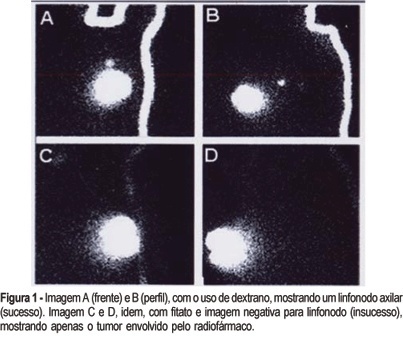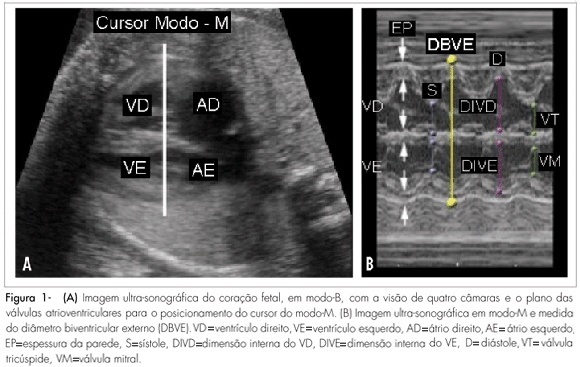Summary
Revista Brasileira de Ginecologia e Obstetrícia. 2005;27(6):340-346
DOI 10.1590/S0100-72032005000600008
PURPOSE: a case-control study comparing two radiocolloids used in scintigraphy to map the sentinel lymph nodes (SLN) in breast cancer patients. METHODS: forty patients were prospectively enrolled between May 2002 and April 2004, after signing an informed consent form. In the present double-blind study, each patient was submitted twice to the same examination, a mammary scintigraphy, one with 99mTc-dextran 500 (dextran) and the other with 99mTc-phytate (phytate), on different days. A volume of 2 ml with 1-1.5 mCi of each radiopharmaceutical, in divided aliquots, was injected in the breast parenchyma in four points around in the tumor and the subcutaneous area superficial to the tumor. The image was obtained 2 h after the injection, using a gamma camera with high-resolution collimator. The lymph nodes were identified by anterior and lateral static scintigraphic images. Statistical analysis was done with the use of McNemar and Z tests. RESULTS: in the analysis of the 40 patients, we had 15 pairs with positive identical images, 4 pairs with negative images and 21 pairs with inconsistent images, either because one of them was negative, or because the SLN numbers were different. When the protocol was opened, we found 35 and 27 positive images and 5 and 13 negative images for dextran and phytate treatment groups, respectively. Among the negative images, 4 were shared by both groups. The McNemar test, used for the statistical analysis, showed p=0.026, odds ratio (OR) = 0.11 with 95% CI 0.01 < OR < 0.85. The accuracy, evaluated by the success ratio of the SLN mapping, was 67.5% for phytate and 87.5% for dextran, with p=0.032. Analysis of variance of the SLN number in lymphoscintigraphy images showed p=0.008. CONCLUSION: these results recommend the use of dextran instead of phytate for the SLN study of breast carcinoma by scintigraphy, when the same methodology is being used.

Summary
Revista Brasileira de Ginecologia e Obstetrícia. 1999;21(6):341-345
DOI 10.1590/S0100-72031999000600007
Objectives: to analyze the medical and legal aspects in order to contribute to the study and standardization of this obstetrical surgery in Brazil. Methods: our study was based on 11 cases of cesarean section performed in the imminence of maternal death or just after death. These cases were attended at UNIFESP - EPM from 1988 to 1998. Results: there were 7 live births, five of them with a gestational age over 26 weeks. Most deaths occurred within the first 48 hours after admission. The predominant age range was the third decade. Conclusions: although postmortem cesarean section is indicated to save the fetus, it is rarely performed. The conditions for its indication involve knowledge of the technique as well as of the ethical and legal principles.
Summary
Revista Brasileira de Ginecologia e Obstetrícia. 2008;30(7):341-348
DOI 10.1590/S0100-72032008000700004
PURPOSE: to verify the correlation between ultrasonography heart measures and hemoglobin deficit in fetuses of alloimmunized pregnant women. METHODS: a transversal study, including 60 fetuses, with 21 to 35 weeks of gestational age, from 56 isoimmunized pregnant women. A number of 139 procedures were performed. Before cordocentesis for the collection of fetal blood, cardiac measures and femur length (FL) were assessed by ultrasonography. The external biventricular diameter (EBVD) was obtained by measuring the distance between the epicardic external parts at the end of the diastole, with the M-mode cursor perpendicular to the interventricular septum, in the atrioventricular valves. The measure of the atrioventricular diameter (AVD) was obtained by positioning the same cursor along the interventricular septum, evaluating the distance between the heart basis and apex. The FL was determined from the trochanter major to the distal metaphysis. The cardiac circumference (CC) was also calculated. To adjust the cardiac measure to the gestational age, each of these measures were divided by the FL measure. Hemoglobin concentration has been determined by spectrophotometry with the Hemocue® system. Hemoglobin deficit calculation was based in the Nicolaides's normality curve. RESULTS: direct and significant correlations were observed between the cardiac measures evaluated and the hemoglobin deficit. To predict moderate and severe anemia, the sensitivity and specificity found were 71.7 and 66.3% for EBVD and FL, 65.8 and 62.4% for AVD and FL, and 73.7 and 60.4% for CC and FL, respectively. CONCLUSIONS: ultrasonography cardiac measures assessed from fetuses of isoimmunized pregnant women correlate directly with hemoglobin deficit.

Summary
Revista Brasileira de Ginecologia e Obstetrícia. 2021;43(4):341-346
Summary
Revista Brasileira de Ginecologia e Obstetrícia. 2011;33(11):341-347
DOI 10.1590/S0100-72032011001100004
PURPOSE: To evaluate the pregnancy rate in intrauterine insemination (IUI), and to determine possible prognostic factors of successful pregnancy. METHODS: A retrospective study of IUI cycles performed in the Reproductive Medicine Unit of Vila Nova de Gaia Hospital, between January 2007 and July 2010. The IUI cycles were preceded by ovarian stimulation and monitored by vaginal ultrasound. Clinical pregnancy rates were analyzed according to the woman’s age, type and duration of infertility, spermatozoa parameters assessed in the spermogram, number of mature follicles and the drug used for ovarian stimulation. Statistical analysis was performed using the Statistical Package for the Social Sciences (SPSS17), with the level of significance set at p<0.05. RESULTS: The study comprised 139 couples who underwent 220 IUI cycles. The absolute pregnancy rate per cycle was 18.6%. Of the 41 clinical pregnancies, 5 were twin pregnancies (12.1%). The pregnancy rate was higher at ages <30 years (28.5 vs 15.7%; p=0.024), duration of infertility <3 years (23.8 vs 13.9%; p=0.05), normal sperm motility (23.2 vs 10.3%; p=0.01) and with two follicles at the time of insemination (27.7 vs 14.2% for monofollicular growth; p=0.030). The pregnancy rates obtained with clomiphene citrate, gonadotropins and combined clomiphene citrate/gonadotropin were 13.0, 26.1 and 28.6%, respectively, with a statistically significant difference in clinical pregnancy rate between clomiphene citrate and gonadotropin. CONCLUSIONS: IUI remains a natural starting point for conveniently selected couples with infertility. Younger age and normal sperm motility are good prognostic factors. Gonadotrophin stimulation seems to be an important tool for improving the pregnancy rate of IUI.
Summary
Revista Brasileira de Ginecologia e Obstetrícia. 2009;31(7):342-348
DOI 10.1590/S0100-72032009000700004
PURPOSE: to compare echographical cardiovascular risk factors between obese and non-obese patients with micropolycystic ovarian syndrome (MPOS). METHODS: in this transversal study, 30 obese (Body Mass Index, BMI>30 kg/m²) and 60 non-obese (BMI<30 kg/m²) MPOS patients, aging between 18 and 35 years old, were included. The following variables were measured: flow-mediated dilatation (FMD) of the brachial artery, thickness of the intima-media of the carotid artery (IMT), anthropometric data, systolic arterial pressure (SAP) and diastolic arterial pressure (DAP). The women had no previous medical treatment and no comorbidity besides MPOS and obesity. For statistical analysis, the non-paired tand Mann-Whitney's tests were used. RESULTS: obese weighted more than non-obese patients (92.1±11.7 kg versus 61.4±10.7 kg, p<0.0001) and had a larger waist circumference (105.0±10.4 cm versus 78.5±9.8 cm, p<0.0001). The SBP of obese patients was higher than that of the non-obese ones (126.1±10.9 mmHg versus 115.8±9.0 mmHg, p<0.0001) and the IMT was also bigger (0.51±0.07 mm versus 0.44±0.09 mm, p<0.0001). There was no significant difference between the groups as to FMD and carotid rigidity index (β). CONCLUSIONS: obesity in young women with MPOS is associated with higher blood pressure and alteration of arterial structure, represented by a thicker intima-media of the carotid artery.
Summary
Revista Brasileira de Ginecologia e Obstetrícia. 1998;20(6):342-349
DOI 10.1590/S0100-72031998000600007
Objectives: to determine prognostic factors for vaginal delivery in pregnant women after previous cesarean section admitted to CAM-IMIP in labor.Patients and Methods: a case-control study was performed, analyzing all deliveries of patients with previous cesarean section admitted to CAM-IMIP between January 1991 and December 1994. Patients who had a cesarean section (n=156) were considered cases while patients with a vaginal birth were the controls (n=338). Inclusion criteria were: gestational age > 36 weeks, previous cesarean section at least 1 year before, alive fetus, spontaneous labor and vertex presentation. Patients with high-risk pregnancies, acute fetal distress and a previous vaginal delivery after cesarean section were excluded. Statistical analysis was performed with in Epi-Info 6.0 and Epi-Soft, using c² test, Fisher's exact test and Student's "t" test. Odds ratio and its 95% confidence interval was calculated and multiple logistic regression analysis was performed for the control of confounding factors. Results: overall rate of cesarean section was 31.6%. Maternal factors significantly associated with vaginal delivery were age < 20 years (OR = 2.07, 95% CI = 1.18-3.66) or > 35 years (OR = 0.54, 95% CI = 0.36-0.82), history of vaginal delivery (OR = 1.6, 95% CI = 1.01-2.55) and complications of pregnancy as indication for previous cesarean section (OR = 3.67, 95% CI =1.19-12.02). A significant association with vaginal delivery could not be detected for other variables: interval between previous cesarean section and present delivery, other indications for cesarean section and type of uterine suture. In a multiple logistic regression model the variables that remained associated with vaginal delivery were maternal age and previous vaginal delivery. Conclusions: maternal age below 20 years, previous cesarean section indicated due to gestational complications and previous vaginal delivery were favorably associated with vaginal delivery in patients with prior cesarean section. Risk of repeated cesarean section is increased in pregnant women aged 35 years or above. These factors should be contemplated when obstetrical evaluation of the delivery route is performed.
Summary
Revista Brasileira de Ginecologia e Obstetrícia. 2013;35(8):342-348
DOI 10.1590/S0100-72032013000800002
PURPOSE: To determine maternal and perinatal outcomes in pregnant women with low amniotic fluid, according to the amniotic fluid index (AFI). METHODS: A cohort study conducted on 176 patients admitted to the high risk ward of Instituto de Medicina Integral Prof. Fernando Figueira (IMIP), in Recife, Pernambuco, Brazil. Amniotic fluid was measured by the amniotic fluid index, and classified as low when between 5.1 and 7.9 cm, moderate oligohydramnios between 3.1 and 5.0 cm, and severe oligohydramnios when less than or equal to 3.0 cm. To determine the difference between the three groups of categorical variables studied the chi-square and Fisher exact tests were used, when applicable, and for the numerical variables the Mann-Whitney test was applied, with the level of significance set at 5%. RESULTS: Fetal malformation more frequently occurred when oligohydramnios was severe. Hypertensive disorders, however, were associated with moderate oligohydramnios. There was similarity between the three groups in relation to premature rupture of membranes and other causes. Low amniotic fluid was more frequently diagnosed when tested at the gestational age of 32 weeks or earlier. Regarding the perinatal outcomes, the incidence of Apgar score <7 in the 1st and 5th minutes, perinatal death, neonatal jaundice and pulmonary hypoplasia was higher when oligohydramnios was moderate to severe. CONCLUSIONS: Maternal and perinatal causes and outcomes in pregnant women with low amniotic fluid vary with respect to their AFI, severe oligohydramnios being associated with fetal malformation and other adverse perinatal outcomes.